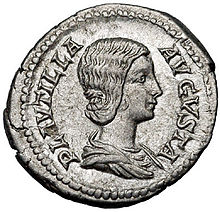Fulvia Plautilla

Publia Fulvia Plautilla († 211 on Lipari ) was the wife of the later Roman emperor Caracalla from 202 to 205 . After the marriage was dissolved, she was banished. After Caracalla came to power, he had his former wife murdered.
Life
Plautilla's father was the Praetorian prefect Gaius Fulvius Plautianus . Plautianus came from Leptis Magna in Libya, the hometown of the Emperor Septimius Severus (193-211), the father of Caracallas. Plautianus had achieved an extraordinary position of power under Septimius Severus. As the contemporary historian Cassius Dio reports, he had Plautilla trained in music and other arts, although he only tolerated eunuchs as a teacher .
Plautianus wanted to cement his position by marriage with the imperial family. His influence on the emperor was so great that Septimius Severus married Caracalla, the older of his two sons, to Plautilla against his will in April 202. She received the title Augusta . Caracalla saw Plautianus as a rival for power; he hated his wife and father-in-law and wanted to get rid of them as soon as possible. As the historian Herodian reports, he refused to dine with his wife and to consummate the marriage, and threatened to kill her and her father if he came to power. Plautilla informed her father about this. The modern assumption that Caracalla and Plautilla nevertheless had a child is based on inadequate evidence. Plautilla probably took part in the Africa trip of the imperial family 202–203.
The ambition of Plautianus was perceived as a threat by the Empress Julia Domna and brought him into conflict with her. Finally, in 205, Caracalla succeeded in intrigue to bring about the overthrow of Plautianus. He had the powerful Praetorian prefect killed in the presence of the emperor. Plautilla and her brother Gaius Fulvius Plautius Hortensianus were exiled to the island of Lipara (now Lipari). After the death of Septimius Severus on February 4, 211, Caracalla and his brother Geta succeeded him. Soon after, he had his former wife and her brother killed and the damnatio memoriae (erasure of memory) imposed on Plautilla.
Little is known about Plautilla's personality. Cassius Dio describes them as extremely shameless.
iconography
Her coin portraits are decisive for determining Plautilla's appearance. A large part of the round sculptures probably fell victim to the damnatio memoriae , which - as the destroyed portraits of Geta show - was thoroughly carried out at the time. Some were only removed from the public and stored. According to the current state of research, some of the round sculptural portraits that have been preserved can be assigned to Plautilla. On the reverse of a coin by Plautilla, Caracalla and Plautilla hold their right hands; the inscription is Concordiae aeternae ("For eternal harmony").
literature
General
- Arthur Stein : Pu (blia) Fulvia Plautilla Augusta . In: Prosopographia Imperii Romani , 2nd edition, part 3, de Gruyter, Berlin and Leipzig 1943, pp. 223f. (F 564)
iconography
- Heinz Bernhard Wiggers : Plautilla . In: Heinz Bernhard Wiggers, Max Wegner : Caracalla, Geta, Plautilla. Macrinus to Balbinus (= Max Wegner (Hrsg.): The Roman image of rulers , section 3, volume 1). Gebrüder Mann, Berlin 1971, ISBN 3-7861-2147-8 , pp. 115-129
- Klaus Fittschen , Paul Zanker : Catalog of the Roman portraits in the Capitoline Museums and the other municipal collections of the city of Rome . Volume 3, Philipp von Zabern, Mainz 1983, ISBN 3-8053-0582-6 , text volume p. 30, panel volume panel 40 (No. 32)
Remarks
- ↑ Cassius Dio 76 (75), 14: 4-5. When specifying some of the books of Cassius Dio's work, different counts are used; a different book count is given here and below in brackets.
- ↑ For the background, see Barbara Levick : Julia Domna. Syrian Empress , London 2007, p. 75.
- ↑ Herodian 3,10,8.
- ^ Achim Lichtenberger : Severus Pius Augustus , Leiden 2011, pp. 274-276.
- ^ Anthony R. Birley : The African Emperor. Septimius Severus , 2nd expanded edition, London 1988, p. 146.
- ↑ See also Barbara Levick: Julia Domna. Syrian Empress , London 2007, pp. 75f.
- ↑ For the form of the name see Anthony R. Birley: The African Emperor. Septimius Severus , 2nd, expanded edition, London 1988, p. 221.
- ↑ Cassius Dio 77 (76), 6.3; see. Herodian 3,13,2-3.
- ↑ Cassius Dio 77 (76), 6.3 and 78 (77), 1.1; Herodian 4,6,3.
- ↑ Cassius Dio 77 (76), 3.1.
- ↑ For the different types of coin portraits see Eric R. Varner: Mutilation and Transformation. Damnatio Memoriae and Roman Imperial Portraiture , Leiden 2004, p. 164f.
- ↑ On the implementation of Plautillas damnatio memoriae see Eric R. Varner: Mutilation and Transformation. Damnatio Memoriae and Roman Imperial Portraiture , Leiden 2004, pp. 165–168.
- ^ Heinz Bernhard Wiggers: Plautilla . In: Heinz Bernhard Wiggers, Max Wegner: Caracalla, Geta, Plautilla. Macrinus to Balbinus , Berlin 1971, pp. 115-129, here: 121; Eric R. Varner: Mutilation and Transformation. Damnatio Memoriae and Roman Imperial Portraiture , Leiden 2004, pp. 165–167.
- ↑ Illustration by Bruno Bleckmann : The Severan Family and the Soldier Emperors . In: Hildegard Temporini-Gräfin Vitzthum (ed.): Die Kaiserinnen Roms , Munich 2002, pp. 265–339, here: 273.
| personal data | |
|---|---|
| SURNAME | Plautilla, Fulvia |
| ALTERNATIVE NAMES | Plautilla, Publia Fulvia (full name) |
| BRIEF DESCRIPTION | Wife of the later Roman emperor Caracalla |
| DATE OF BIRTH | 2nd century |
| DATE OF DEATH | 211 |
| Place of death | Lipari |